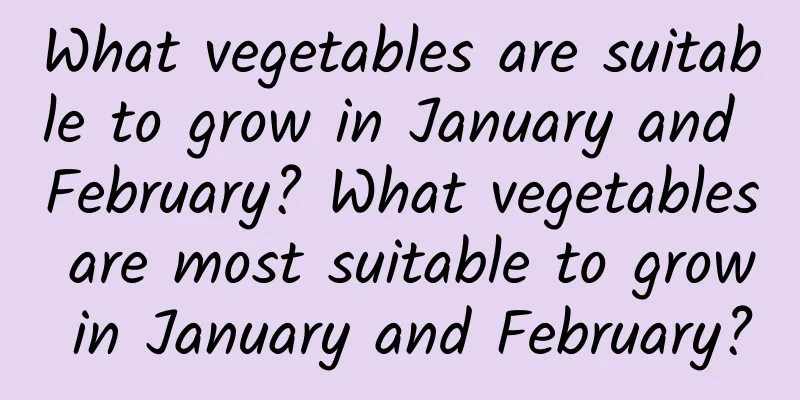What vegetables are suitable to grow in January and February? What vegetables are most suitable to grow in January and February?

|
The climate is still relatively cold in January and February, so when planting, try to choose frost-resistant vegetables, such as cabbage, spinach, onions, leeks, carrots, green vegetables, cabbage, water chestnuts, rapeseed, tomatoes, peppers, etc. These vegetables are very common and have low requirements for the environment. Not only are they simple to plant, they are also easy to manage. 1. Spinach Spinach has a certain degree of cold resistance and is suitable for planting in early spring in February, especially in the northern region. The temperature in the northern region is still unstable at this time. Spinach can withstand short periods of low temperatures and can grow well at this time. It usually matures 30-50 days after planting. 2. Carrots Carrots can be planted in early spring or autumn. When planting, you should choose a plot with high terrain, convenient drainage, and deep soil. Only in such a soil environment can they germinate better. If you want it to grow more vigorously in the later stage, you must also apply enough base fertilizer before planting. 3. Cabbage It is also suitable to plant cabbage in early spring in February. Cabbage likes a cool environment. If it is cultivated in high temperatures, it is easy to be infected by diseases and pests. However, it is best not to plant it in the southern region at this time. Cabbage should be sown in early spring and harvested in summer. 4. Green onions It is also suitable to plant green onions around February. They have a certain degree of cold resistance. When planting, you should choose a plot with deep and fertile soil. After planting, you should strengthen management, water them in time, loosen the soil, and do a good job of drainage in the rainy season. The growing period of green onions is 120-150 days. Tips for growing vegetables in January and February1. Insulation and cold prevention: Vegetables planted in January and February are easily attacked by late spring cold, which causes a sharp drop in temperature. In addition, the plants have a relatively low resistance to cold, resulting in frost and chilling damage to vegetables. It is necessary to strengthen insulation and warming work, and seal the greenhouse before the late spring cold arrives. 2. Ventilation and light transmission: After the temperature rises, the humidity in the greenhouse will increase significantly, which will affect the growth of vegetables and increase the occurrence of diseases. At this time, attention should be paid to ventilation and light transmission to reduce the humidity in the greenhouse. At the same time, harmful gases in the greenhouse, such as ammonia and sulfur dioxide, can be discharged in time. 3. Disease prevention and control: Excessive humidity in the vegetable shed can easily cause gray mold and other diseases. Pay attention to ventilation. After the spring, prevent sudden wilt, damping-off, root rot, downy mildew, anthracnose, early blight, eggplant brown streak disease, sclerotinia, celery spot blight, etc., and also prevent and control aphids. |
>>: What vegetables are suitable for growing during the Dragon Boat Festival?
Recommend
Shrimp farming technology and methods
As a kind of aquatic product with extremely high ...
The growth environment and local conditions of money grass
Growth environment and conditions of money grass ...
How many kilograms of greenhouse tomatoes are produced per mu?
Greenhouse tomato yield per mu The specific yield...
Does cilantro need to be watered every day?
Do you water cilantro every day? Coriander is a p...
Management of potted jasmine after cutting
Temperature management of potted jasmine The temp...
Is Christmas cactus cold-resistant?
1. Is it cold-resistant? It is a tropical plant, ...
What is water hyacinth?
1. What is the plant? It is a floating herb with ...
Cultivation methods and precautions for small fern pots
1. Maintenance methods 1. Soil: It is best to cho...
Can melon seeds be planted?
Can melon seeds be planted? Melon seeds can be pl...
What to do if Phalaenopsis leaves have black spots
1. Proper sunshade Reason: Phalaenopsis cannot be...
How long does it take for ginkgo tree cuttings to take root?
Ginkgo tree cutting rooting time There are two wa...
Differences between Lychee Tree and Longan Tree
1. Difference of blades The litchi tree has odd- ...
How to make winter red bloom on New Year's Day
Normal flowering period of plants Generally speak...
This kind of "flower" blooms 365 days a year, but some people still don't know it. Friends who like flowers should not miss it.
1. Bougainvillea Many people have seen bougainvil...
Environmental conditions and characteristics of the growth of Kapok trees
Environmental conditions and requirements for the...









